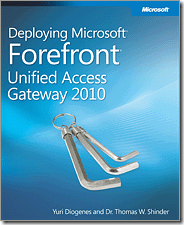Easy Access to Unified Access Gateway!
 The “Deploying” series of books Microsoft Press have brought out are short to the point manuals. The three published all cover the Forefront Product range, Threat Management Gateway 2010, Forefront Protection 2010 for Exchange Server and this one Forefront Unified Access Gateway 2010. Will there be more? I don’t know. What I do know is that the format is an interesting departure from the traditional Resource kit or Administrators companion. I recently reviewed Deploying Microsoft Forefront Threat Management Gateway 2010 and made comparisons to Microsoft Forefront Threat Management Gateway (TMG) Administrator's Companion which I’d reviewed previous. Shameless plugs for my blog aside, with UAG there isn’t that comparison available. There is only one other book on UAG that I’m aware of, Microsoft Forefront UAG 2010 Administrator's Handbook from Packt publishing, which I’ve not read.
The “Deploying” series of books Microsoft Press have brought out are short to the point manuals. The three published all cover the Forefront Product range, Threat Management Gateway 2010, Forefront Protection 2010 for Exchange Server and this one Forefront Unified Access Gateway 2010. Will there be more? I don’t know. What I do know is that the format is an interesting departure from the traditional Resource kit or Administrators companion. I recently reviewed Deploying Microsoft Forefront Threat Management Gateway 2010 and made comparisons to Microsoft Forefront Threat Management Gateway (TMG) Administrator's Companion which I’d reviewed previous. Shameless plugs for my blog aside, with UAG there isn’t that comparison available. There is only one other book on UAG that I’m aware of, Microsoft Forefront UAG 2010 Administrator's Handbook from Packt publishing, which I’ve not read.
So what about this book? Top line, 138 pages in e-form, 5 chapters, and covers what UAG is, how to install UAG and then how to publish applications, SSL VPN and DirectAcess through it. It is that concise, but the devil is in the detail. While seeming small, it does cover a lot of the really detailed information you need to perform the tasks covered. There is a lot of detail on DirectAccess, even though the wizard does a lot of the hard work for you, they authors covers the recommendations for implementing this solution. If you’ve not looked at DirectAccess as an access solution for remote users I’d say it’s worth a look. I use constantly and I think it is absolutely marvellous. Now having read chapter 5 in this guide, I have a good understanding of how UAG enhances the solution. I saw a session at a User Group meeting last year on how to configure the Windows Server 2008 R2 implementation of Direct Access and that now seems very daunting compared to the UAG solution.
Enough on DirectAccess, the whole purpose of UAG is to provide an access solution that is secure, saleable and manageable. This book covers the details of how to get the product up and running, remember the title, “deploying”, that covers how UAG provides the security and scalability portions, not the management. This publication, along with the other two, does not provide a complete guide to the products. In case of TMG, the administrators’ companion goes into more detail, and the deploying guide references that book a lot. In UAG’s case, there are pointers to more information on various TechNet pages and also Dr. Thomas Shinder’s blog. If you do deploy UAG, then the Threat Management Gateway Administrators Companion could well be a good investment later. UAG installs TMG and while you manage TMG from within UAG, understanding what the features are and how to configure them will come up.
The other key area the book covers is around the applications UAG supports. The core of this is in chapter 3, which covers Exchange, Remote Desktop Services and SharePoint. The chapter mainly covers the wizards that implement the access through UAG; the assumption is that you have these services running already. This approach does highlight the ease with which it is possible to make these services available and granularity of control. Something, that while possible with TMG, is not as straightforward.
The later chapter on SSL VPN, follows a similar lines, there are good discussions on how UAG implements SSL VPN, and later one on the merits of DirectAccess versus SSL VPN. As with all the chapters there are step-by-step instructions for using the wizards. Size limits having step-by-steps for all scenarios, but the various are covered.
Who should invest in this? If you are primarily focused on getting up to speed on what UAG is and how it can be implemented into your organisation, then this is an ideal read. I myself thoroughly enjoyed reading it, and felt I learnt a lot about UAG. If you have UAG already, or someone else is deploying it, then you are better off reading isaserver.org or UAG on TechNet